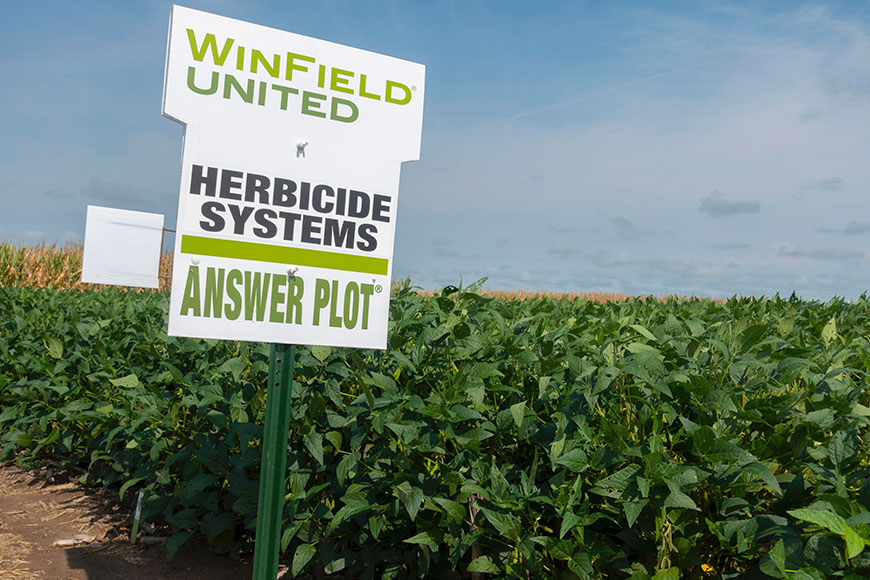Managing Against Herbicide-Resistant Weeds in Wheat

Managing Against Herbicide-Resistant Weeds in Wheat
Kyle Okke
Agronomist
Dickinson, ND
Weed resistance is a popular topic of conversation in any growing season, as it’s a problem that impacts every farmer regardless of location.
Repeated use of a specific herbicide can lead to resistance by means of selection pressure on a weed population. Natural mutations exist in weeds that can confer tolerance to a particular herbicide. Resistance problems begin because a few plants in the population have this mutation, enabling them to survive that specific herbicide treatment. When that same herbicide is used year after year, the susceptible biotypes are eliminated while the naturally resistant weeds are able to reproduce unchecked.
These resistant weeds typically go unnoticed in a field in the first few years after they first appear because populations are relatively small and can be mistaken for sprayer error, but eventually the resistant population spreads. That’s why it’s important for farmers to proactively switch up the chemistries they use in their fields before resistant weed populations thrive.
The top 3 culprits
Starting with the most troublesome, the top three herbicide-resistant weeds in spring wheat are:
Since each of these weeds have populations that are resistant to ALS inhibitors and glyphosate herbicides, a lot of farmers have long relied on products than contain fluroxypyr and clopyralid to control kochia, like Weld® and Widematch® herbicides.
Despite sparse reports of fluroxypyr-resistant kochia, these herbicides continue to be viable control options for the time being. But as history has taught us, there’s potential for development of resistance to any herbicide or herbicide system.
Rotate modes of action
For that reason, we need to consider going back to using some of the chemistries that are just as effective, provided they are sprayed when weeds are smaller. For example, some wheat producers are using other multiple modes-of-action products like Bison®, Kochiavore® and Carnivore® herbicides. These herbicides contain bromoxynil, which is a very good active ingredient from a resistance standpoint, but it offers less flexibility and requires accurate application timing to achieve optimal control.
Kochiavore® and Carnivore® both have the addition of fluroxypyr, which provides more flexibility in application and multiple modes of action. Products like Huskie® and Talinor® contain bromoxynil and a HPPD inhibitor, which is a unique mode of action to the previously mentioned herbicides. What is most important here is to make sure that there is not a repeated use of the same mode of action.
Crop rotation
Another effective way to introduce alternative chemistries on your acres is to rotate crops, as it enables you to use a different weed management system for a year or two before returning to wheat. For instance, rotating into CROPLAN® LibertyLink® soybeans gives you the opportunity to use a glufosinate product like Liberty® herbicide to control ALS inhibitor- and glyphosate-resistant common ragweed, waterhemp and kochia, among other broadleaf weeds.
Depending on what’s planted in surrounding fields, I expect farmers will also begin to try some of the new soybean traits that have been developed so they can change up the chemistries they use. These include CROPLAN Roundup Ready 2 Xtend® soybeans, which are tolerant to dicamba and glyphosate herbicides, and Enlist E3® soybeans, which are tolerant to 2,4-D, glyphosate and glufosinate herbicides.
Other weed management practices
Rotating modes of action and crops are only two of several ways to combat weed resistance. Since no single practice will be entirely successful on its own, every little bit helps. Other weed control measures include:
Future weed concern
If I had to pick only one weed that could join the ranks of marestail, waterhemp and kochia in the next 5 to 10 years as the most troublesome weeds in wheat, it would be Palmer amaranth. This invasive weed has wreaked havoc throughout the southern United States and its advancement and spread has reached states like Minnesota and South Dakota. It was also discovered in multiple North Dakota millet fields in 2019; it is suspected that it came with the millet seed that was planted. This weed can cause devastating yield loss if not controlled, and control is difficult to achieve due to a number of challenges:
For more information about managing against weed resistance in your wheat acres, contact your locally owned and operated WinField® United retailer.
© 2020 WinField United. Important: Before use always read and follow label instructions. Crop performance is dependent on several factors many of which are beyond the control of WinField United, including without limitation, soil type, pest pressures, agronomic practices, and weather conditions. Growers are encouraged to consider data from multiple locations, over multiple years, and be mindful of how such agronomic conditions could impact results. Bison®, Carnivore®, CROPLAN®, Kochiavore®, Weld® and WinField® are registered trademarks of WinField United. Roundup Ready 2 Xtend® is a registered trademark used under license from Bayer Group. Huskie®, Liberty® and LibertyLink® are registered trademarks of Bayer CropScience. Talinor® is a trademark of a Syngenta Company. Enlist E3® and Widematch® are registered trademarks of Dow AgroSciences LLC.
Kyle Okke
Agronomist
Dickinson, ND
Weed resistance is a popular topic of conversation in any growing season, as it’s a problem that impacts every farmer regardless of location.
Repeated use of a specific herbicide can lead to resistance by means of selection pressure on a weed population. Natural mutations exist in weeds that can confer tolerance to a particular herbicide. Resistance problems begin because a few plants in the population have this mutation, enabling them to survive that specific herbicide treatment. When that same herbicide is used year after year, the susceptible biotypes are eliminated while the naturally resistant weeds are able to reproduce unchecked.
These resistant weeds typically go unnoticed in a field in the first few years after they first appear because populations are relatively small and can be mistaken for sprayer error, but eventually the resistant population spreads. That’s why it’s important for farmers to proactively switch up the chemistries they use in their fields before resistant weed populations thrive.
The top 3 culprits
Starting with the most troublesome, the top three herbicide-resistant weeds in spring wheat are:
- Waterhemp (Resistant to herbicide Groups 2, 9 and 14)
- Kochia (Groups 2, 4 and 9)
- Marestail (Groups 2, 9)
Since each of these weeds have populations that are resistant to ALS inhibitors and glyphosate herbicides, a lot of farmers have long relied on products than contain fluroxypyr and clopyralid to control kochia, like Weld® and Widematch® herbicides.
Despite sparse reports of fluroxypyr-resistant kochia, these herbicides continue to be viable control options for the time being. But as history has taught us, there’s potential for development of resistance to any herbicide or herbicide system.
Rotate modes of action
For that reason, we need to consider going back to using some of the chemistries that are just as effective, provided they are sprayed when weeds are smaller. For example, some wheat producers are using other multiple modes-of-action products like Bison®, Kochiavore® and Carnivore® herbicides. These herbicides contain bromoxynil, which is a very good active ingredient from a resistance standpoint, but it offers less flexibility and requires accurate application timing to achieve optimal control.
Kochiavore® and Carnivore® both have the addition of fluroxypyr, which provides more flexibility in application and multiple modes of action. Products like Huskie® and Talinor® contain bromoxynil and a HPPD inhibitor, which is a unique mode of action to the previously mentioned herbicides. What is most important here is to make sure that there is not a repeated use of the same mode of action.
Crop rotation
Another effective way to introduce alternative chemistries on your acres is to rotate crops, as it enables you to use a different weed management system for a year or two before returning to wheat. For instance, rotating into CROPLAN® LibertyLink® soybeans gives you the opportunity to use a glufosinate product like Liberty® herbicide to control ALS inhibitor- and glyphosate-resistant common ragweed, waterhemp and kochia, among other broadleaf weeds.
Depending on what’s planted in surrounding fields, I expect farmers will also begin to try some of the new soybean traits that have been developed so they can change up the chemistries they use. These include CROPLAN Roundup Ready 2 Xtend® soybeans, which are tolerant to dicamba and glyphosate herbicides, and Enlist E3® soybeans, which are tolerant to 2,4-D, glyphosate and glufosinate herbicides.
Other weed management practices
Rotating modes of action and crops are only two of several ways to combat weed resistance. Since no single practice will be entirely successful on its own, every little bit helps. Other weed control measures include:
- Planting certified or quality assured weed-free seed like CROPLAN wheat varieties.
- Strategic tilling to suppress resistant weeds in trouble areas.
- Cleaning tillage and harvest equipment to prevent transferring weed residue and seeds to neighboring fields.
- Applying pre-emergent tank mixes with multiple modes of action.
- Using full herbicide rates and quality adjuvants.
- Actively scouting your fields for surviving weeds or regrowth.
- Managing weeds in field borders to slow spreading.
- Use of cover crops like winter rye to suppress weed growth.
Future weed concern
If I had to pick only one weed that could join the ranks of marestail, waterhemp and kochia in the next 5 to 10 years as the most troublesome weeds in wheat, it would be Palmer amaranth. This invasive weed has wreaked havoc throughout the southern United States and its advancement and spread has reached states like Minnesota and South Dakota. It was also discovered in multiple North Dakota millet fields in 2019; it is suspected that it came with the millet seed that was planted. This weed can cause devastating yield loss if not controlled, and control is difficult to achieve due to a number of challenges:
- Produces a lot of seed, often between 250,000 to 500,000 seeds per plant.
- Distributes small seeds that thrive in no-till or minimum tillage fields.
- Competes aggressively, growing 2 or 3 inches per day under ideal conditions.
- Herbicide-resistant populations have been reported with resistance to Groups 2, 3, 5, 9, 14 and 27.
- Emerges for an extended period of time, forcing farmers to manage it throughout the year unlike other summer annual weeds that are typically only encountered through early summer.
For more information about managing against weed resistance in your wheat acres, contact your locally owned and operated WinField® United retailer.
© 2020 WinField United. Important: Before use always read and follow label instructions. Crop performance is dependent on several factors many of which are beyond the control of WinField United, including without limitation, soil type, pest pressures, agronomic practices, and weather conditions. Growers are encouraged to consider data from multiple locations, over multiple years, and be mindful of how such agronomic conditions could impact results. Bison®, Carnivore®, CROPLAN®, Kochiavore®, Weld® and WinField® are registered trademarks of WinField United. Roundup Ready 2 Xtend® is a registered trademark used under license from Bayer Group. Huskie®, Liberty® and LibertyLink® are registered trademarks of Bayer CropScience. Talinor® is a trademark of a Syngenta Company. Enlist E3® and Widematch® are registered trademarks of Dow AgroSciences LLC.





